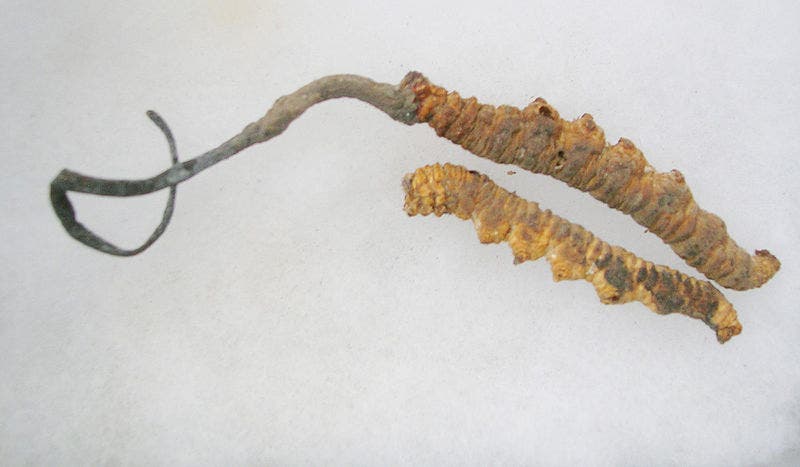
During the summer days, thousands gather on the Tibetan plateau on the lookout for that year’s most prized commodity — buried orange sticks that look like withered carrots with a dark-brown rod at the top. The orange lump is, in fact, a dead caterpillar while the stick is a parasitic fungus that has devoured the unfortunate insect. If you’re not impressed yet, understand that the caterpillar fungus can sell for three times more than gold, kilogram for kilogram.
But a new study is confirming what many who harvest the highly prized fungus have known deep down for quite some time: the world’s most valuable parasite is disappearing. The culprit is overharvesting with a sprinkle of — what’s by now a usual suspect — climate change.
The fungal ‘gold mine’ is running out
Ophiocordyceps sinensis, known as Yarsa-gumba (यार्सागुम्बा, which is Nepali for “winter worm, summer grass”) is an entomopathogenic fungus that grows on insects, particularly the larvae of moths within the family Hepialidae.
Thousands of people living in Tibet and neighboring Bhutan depend on the caterpillar fungus for their livelihoods. They harvest the fungus and then sell it to dealers that bring it to markets in China. The caterpillar fungus is highly regarded in traditional Chinese and Tibetan medicine, where it’s used as an immune system booster and to treat all sorts of conditions, including cancer.
The caterpillar fungus’ anti-cancer properties have never been proven in a clinical trial. However, there are studies that suggest the fruiting body has some pharmaceutical effects that can be used to treat conditions such as hyposexuality, night sweats, hyperglycemia, hyperlipidemia, asthenia, arrhythmias, and other heart, respiratory, renal and liver diseases. It, at least, does not seem worthless in medicine like rhino horn (Chinese market demand is threatening the iconic animals with extinction). But is it worth its hefty price?

In 2008 the price of C. sinensis was around USD $13,000 per kg, earning it the name “soft gold” in China. As of August 2012, the price rose to USD $111,560 per kg and, according to The Atlantic’s Ed Young, some of the biggest and most attractive pieces can fetch $140,000 per kilogram — more than three times the price of gold.
The global market for “soft gold” is estimated to be worth $5 billion to $11 billion, contributing a hefty chunk of Tibet’s and Bhutan’s GDP. It’s estimated that 40% of the rural cash income in the Tibet Autonomous Region comes from the dark-brown fruiting body, supporting hundreds of thousands of people. But their luck seems to be running out.
Kelly Hopping, an ecologist at Boise State University, interviewed hundreds of collectors and went to the field to gather samples and analyze the chilly Himalayan climate. Reporting in the Proceedings of the National Academy of Sciences, Hopping and colleagues found that “harvesters increasingly attribute declining production to overexploitation, while models indicate that climate warming is also contributing to this decline.”
“We find that, according to collectors across four countries, caterpillar fungus production has decreased due to habitat degradation, climate change, and especially overexploitation. Our statistical models corroborate that climate change is contributing to this decline,” the authors of the new study wrote.
According to the researchers, the caterpillar fungus grows best at 3,000 to 5,000 meters above sea level, being most comfortable at temperatures of 5 to 20 degrees Fahrenheit (-15 to -5 Celsius). The problem is that the Himalayan winters have been warming up considerably due to climate change, affecting the harvest of the fungus. Although, it has to be said that the fungus is the least of our worries in the case of a warming Himalayas, whose glaciers are often referred to as the ‘third pole’. These glaciers feed the giant rivers of Asia and meet water demand for over three billion people.
Local authorities are aware of the caterpillar fungus’ decline and, in countries such as Bhutan, there are quotas for how much people are allowed to harvest. The hefty price, however, attracts poachers who — just like in the tragedy of the commons — are quick to seize their chance before someone else beats them to it.
If the caterpillar fungus disappears or dwindles to a shadow of its former self, hundreds of thousands of people will be out of work. This will be a huge challenge for Tibet and Bhutan, whose governments will have to find a way to offer new opportunities for many of its poor and untrained citizens.


